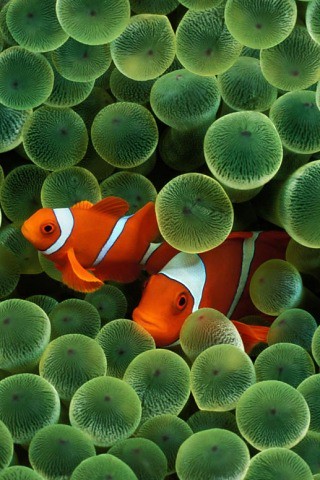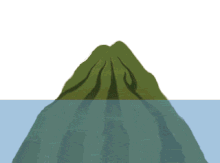
Coral reefs are underwater structures made from calcium carbonate secreted by corals. Corals are colonies of tiny living animals found in marine waters that contain few nutrients. Most coral reefs are built from stony corals, and are formed by polyps that live together in groups. The polyps secrete a hard carbonate exoskeleton which provides support and protection for the body of each polyp. Reefs grow best in warm, shallow, clear, sunny and agitated waters.
Often called “rainforests of the sea”, coral reefs form some of the most diverse ecosystems on Earth. They occupy less than one tenth of one percent of the world ocean surface, about half the area of France, yet they provide a home for twenty-five percent of all marine species, including fish, molluscs, worms, crustaceans, echinoderms, sponges, and tunicates. They are most commonly found at shallow depths in tropical waters, but deep water and cold water corals also exist on smaller scales in other areas.
Coral reefs deliver ecosystem services to tourism, fisheries and shoreline protection. . However, coral reefs are fragile ecosystems, partly because they are very sensitive to water temperature. They are under threat from climate change, ocean acidification, blast fishing, cyanide fishing for aquarium fish, overuse of reef resources, and harmful land-use practices, including urban and agricultural runoff and water pollution, which can harm reefs by encouraging excess algae growth

A Fringing reef is one of the three main types of coral reefs recognized by most coral reef scientists. It is distinguished from the other two main types (barrier reefs and Atolls) in that has either an entirely shallow backreef zone (lagoon) or none at all. If a fringing reef grows directly from the shoreline the reef flat extends right to the beach and there is no back reef.
This type of coral reef is the most common type of reef found in the Carribean and Red Sea.

coral reefs is the most important habitat for fish
BARRIER REEF ~
Barrier reefs are reef systems that parallel the shore and are separated from it by a wide lagoon that contain at least some deep portions.

Examples of large barrier reefs can be found in both the Indo-Pacific and Greater Caribbean, with the Great Barrier Reef of Australia being the prime example.
The very largest barrier reefs develop on the edges of continental shelves (e.g., Great Barrier Reef; Belize Barrier Reef).
The back reef zone and lagoons of shelf barrier reefs are often very extensive, in some cases lying over 100 miles from the mainland in some areas. In contrast, the barrier reef surrounding the narrow lagoon of Bora Bora (above) actually transitions into a fringing reef in a few places.
ATOLLS ~
Atolls are roughly circular (or occasionally horseshoe-shaped) oceanic reef complexes surrounding a large, deep central lagoon.
They are most common in the Indo-Pacific region where over 300 atolls are found, but rare in the Greater Caribbean which houses only about 10-15.
Atolls can exceed 100 miles in diameter and contain lagoons several thousand square miles in extent. The best developed parts of reefs surrounding atolls are on the windward side, where wave energy is greatest.
this dynamic animation shows the dynamic process of corall atoll formation. Corals (represented in tan and purple) settle and grow around an oceanic island, forming a fringing reef. In favourable condition , the reef expands, and the interior island subsides. The process of Atoll formation may take as long as
30 000 000 years. So lets we think a second! Do not destroy our coral reef by throwing plastic bag mehhh!!!
PATCH REEFS ~
The term "patch reef" is commonly used to refer to comparatively small, isolated outcrops of coral surrounded by sand and/or seagrass.
Patch reefs are microscale reef features common to fringing reefs, atolls and barrier reef systems throughout the world.

Ten percent of the world's reefs have been completely destroyed. What has happened to destroy so many reefs? Human population has become very large OR global warming.
There are two different ways in which humans have contributed to the degradation of the Earth's coral reefs, indirectly and directly. Indirectly, we have destroyed their environment. As you read earlier, coral reefs can live only in very clear water.
Warming of the ocean causes corals to sicken and die. Even a rise of one degree in the average water temperature can hurt the coral. Due to global warming, 1998 was the hottest year in the last six centuries and 1998 was the worst year for coral.The most obvious sign that coral is sick is coral bleaching. That is when either the algae inside die, or the algae leave the coral. The algae are what give coral its color, so without the algae the coral has no color and the white of the limestone shell shines through the transparent coral bodies.
This mountainous star coral, Montastraeaa faveolata, from Panama has started to bleach.The warmer water and more nutrients also encourages the growth of harmful algae on top of the coral, which kills it, because it blocks out the sun. Without the sun, the zooxznthellae cannot perform photosynthesis and so they die. Without the zooxanthellae, the coral polyps die too. This algae is usually eaten by fish, but because of over fishing, there aren't enough fish left to eat all the algae.
The direct way in which humans destroy coral reefs is by physically killing them. All over the world, but especially in the Philippines, divers catch the fish that live in and around coral reefs. They sell these fish to fancy restaurants in Asia and to fancy pet stores in the United States. This would be OK if the divers caught the fish carefully with nets and didn't hurt the reefs or take too many fish. But the divers want lots of fish and most of them are not very well trained at fish catching. Often they blow up a coral reef with explosives (picture below) and then catch all the stunned fish swimming around.
Another way that divers catch coral reef fish is with cyanide. Cyanide is a poison. The divers pour this poison on the reef, which stuns the fish and kills the coral. Then they rip open the reef with crowbars and catch the fish while they are too sick from the poison to swim away.
The map below shows the areas in the world where coral reefs are in danger. 
All this may seem a bit depressing, but there are many groups in the world dedicated to saving the coral reefs. These groups work to educate people about the destruction of coral reefs. They lobby the United States Congress as well as the governments of other nations, trying to convince them not to buy fish that have been caught by destroying coral reefs. They encourage governments to crack down on pollution, both into the ocean and into the air, which causes global warming. They encourage visitors to coral reefs to be careful not to harm them. They even build artificial reefs to replace the reefs that have been destroyed.
Some people help coral reefs by convincing governments to treat them with care. Other people help coral reefs by studying them. One way that people learn more about coral reefs is by slicing open dead ones and looking inside. But for me i'm learning coral reef by writing this post and educate people outside there to help coral reef maintain its life. The inside of a coral reef looks a lot like the inside of a tree (picture below) and the lines mean the same thing. A person who studies tree rings is called a dendrochronologist. " Dendro " means tree, " chron " means time and " ologist " means person who studies, so dendrochronologist means person who studies trees through time. Dendrochronologists count the number of rings in a slice of a tree to see how old the tree was when it died. There is one ring for each year the tree lived. The dendrochronologist also looks at the size of the rings. A thick ring means that that year there was lots of food and it was a good year for the tree. A thin ring can mean that there was a drought that year or maybe the tree was sick. The more we know about coral the better we will be able to protect them for years to come.





scuba dive...n coral reef xdpat dipisahkan.. :)
ReplyDelete